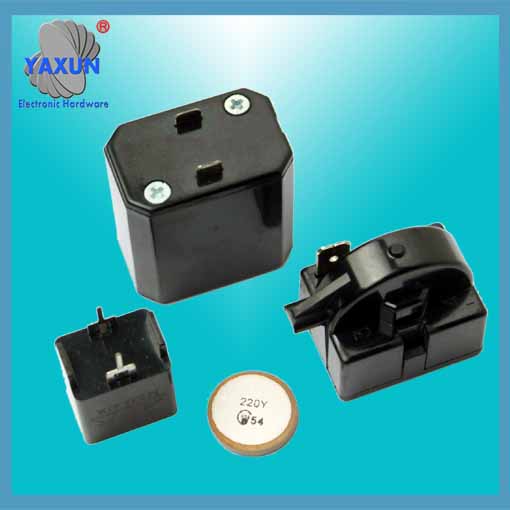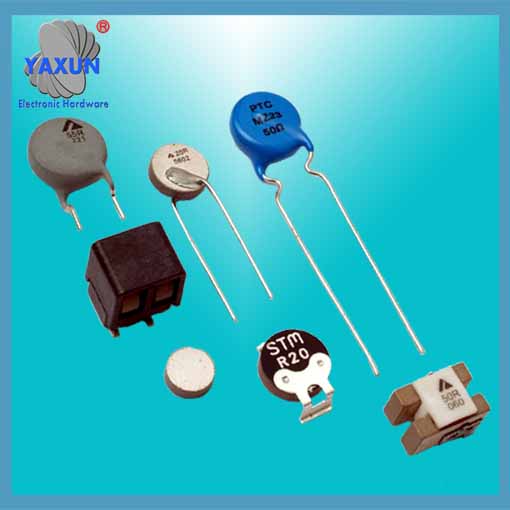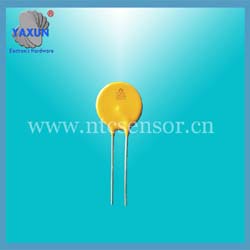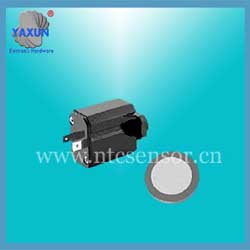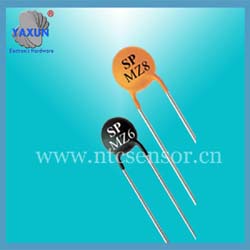CFL preheat soft start smart PTCR thermistor
- PRODUCT DETAIL
I believe that people who have contacted electronic components have learned about thermistors, and the thermistors are roughly divided into these three types: Motor start, electronic ballast and energy-saving lamp preheat soft start.
Shape structure use rules:
When the motor is started, it must suppress its solidity and overcome the reaction force of the load. Therefore, when the motor is started, it needs a large current and torque. After normal operation, in order to save power, the required torque must be greatly reduced. Add a set of auxiliary winding resistors to the motor, which will only run at startup, and will be disconnected after normal. Connect the thermistor in series with the start-up auxiliary winding resistor. After starting, the thermistor enters a high-impedance state to cut off the winding resistance, which is exactly the effect that can be achieved even.
Electronic ballast and energy-saving lamp preheat soft start thermistor
PTCR (Positive Temperature Coefficient of Resistance) is a very positive temperature characteristics of the thermistor,
The main composition is BaTiO3, BaTiO3 ceramics is a typical ferroelectric material,Room temperature resistivity greater than 1012Ω · cm, for the insulator,After semi-doping shows a strong PTC effect - low temperature resistivity,With the increase of temperature,A mutation occurs near the Curie point,Resulting in several orders of magnitude change.
This is because there is a barrier layer on the grain boundaries of the polycrystalline BaTiO3 semiconductor material caused by the surface states,At the Curie temperature,The grain boundary has ferroelectricity,A large dielectric constant,Barrier height is low,Electrons can easily cross the barrier,The corresponding material resistivity is small,However, when the temperature is higher than the Curie temperature,Grain boundary layer,Ferroelectric disappeared,The dielectric constant sharply decreases,According to Curie-Weiss law,So the potential barrier with the rise.With the rapid increase of the barrier height,Electrons are difficult to cross the potential barrier,The resistivity of the corresponding material rises sharply,Macroscopically shows the PTC effect of the material.Due to this characteristic of the PTC thermistor,Whether in industrial electronic equipment or household appliances products,Thermal resistors have been widely used,Its application areas by PTC thermistor can be classified into three basic electrical properties, The basic parameters as shown.
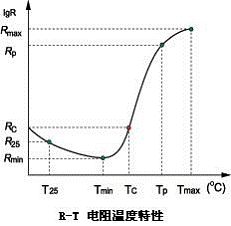
The following figure: Tc Curie temperature: it is the beginning of the PTC semiconductor porcelain phase transition point, usually PTC components Rmin two times the corresponding resistance when the temperature point;
Tmax Maximum temperature: the component reaches the highest resistance when the corresponding temperature;
Tp Maximum operating temperature: the upper limit of the working temperature range;
Tmin Min Temperature: The temperature at which the component (normal) exhibits the minimum resistance;
T25 standard room temperature 25 ℃;
Rc switch resistance: Curie temperature that corresponds to the resistance;
Rmax maximum resistance: the component can achieve the highest resistance;
Rp maximum working resistance: the maximum temperature corresponding to the resistance;
Rmin minimum resistance: the element (normal) can show the minimum resistance;
R25 Room temperature resistance: standard room temperature, the components of the corresponding resistance.
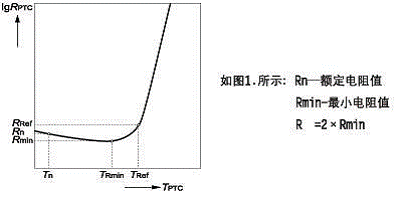
PTCR characteristics
Resistance - temperature characteristics is defined in the specified voltage,Thermistor zero power resistance and the relationship between the temperature of the resistor (Figure 1),Zero power resistance measurement should be carried out in the super thermostatic bath,Usually using pulse voltage,On the pulse power requirements are low output impedance,Output amplitude is stable.Measuring the current caused by PTC thermistor temperature rise,Should be controlled in a negligible range.Figure 2, 3 for the different voltage and frequency resistance-temperature characteristics of the curve,As can be seen from the figure,The resistance at the same temperature,With the test voltage or frequency increases significantly decreased.
Shape structure use rules:
When the motor is started, it must suppress its solidity and overcome the reaction force of the load. Therefore, when the motor is started, it needs a large current and torque. After normal operation, in order to save power, the required torque must be greatly reduced. Add a set of auxiliary winding resistors to the motor, which will only run at startup, and will be disconnected after normal. Connect the thermistor in series with the start-up auxiliary winding resistor. After starting, the thermistor enters a high-impedance state to cut off the winding resistance, which is exactly the effect that can be achieved even.
Electronic ballast and energy-saving lamp preheat soft start thermistor
PTCR (Positive Temperature Coefficient of Resistance) is a very positive temperature characteristics of the thermistor,
The main composition is BaTiO3, BaTiO3 ceramics is a typical ferroelectric material,Room temperature resistivity greater than 1012Ω · cm, for the insulator,After semi-doping shows a strong PTC effect - low temperature resistivity,With the increase of temperature,A mutation occurs near the Curie point,Resulting in several orders of magnitude change.
This is because there is a barrier layer on the grain boundaries of the polycrystalline BaTiO3 semiconductor material caused by the surface states,At the Curie temperature,The grain boundary has ferroelectricity,A large dielectric constant,Barrier height is low,Electrons can easily cross the barrier,The corresponding material resistivity is small,However, when the temperature is higher than the Curie temperature,Grain boundary layer,Ferroelectric disappeared,The dielectric constant sharply decreases,According to Curie-Weiss law,So the potential barrier with the rise.With the rapid increase of the barrier height,Electrons are difficult to cross the potential barrier,The resistivity of the corresponding material rises sharply,Macroscopically shows the PTC effect of the material.Due to this characteristic of the PTC thermistor,Whether in industrial electronic equipment or household appliances products,Thermal resistors have been widely used,Its application areas by PTC thermistor can be classified into three basic electrical properties, The basic parameters as shown.

The following figure: Tc Curie temperature: it is the beginning of the PTC semiconductor porcelain phase transition point, usually PTC components Rmin two times the corresponding resistance when the temperature point;
Tmax Maximum temperature: the component reaches the highest resistance when the corresponding temperature;
Tp Maximum operating temperature: the upper limit of the working temperature range;
Tmin Min Temperature: The temperature at which the component (normal) exhibits the minimum resistance;
T25 standard room temperature 25 ℃;
Rc switch resistance: Curie temperature that corresponds to the resistance;
Rmax maximum resistance: the component can achieve the highest resistance;
Rp maximum working resistance: the maximum temperature corresponding to the resistance;
Rmin minimum resistance: the element (normal) can show the minimum resistance;
R25 Room temperature resistance: standard room temperature, the components of the corresponding resistance.

PTCR characteristics
Resistance - temperature characteristics is defined in the specified voltage,Thermistor zero power resistance and the relationship between the temperature of the resistor (Figure 1),Zero power resistance measurement should be carried out in the super thermostatic bath,Usually using pulse voltage,On the pulse power requirements are low output impedance,Output amplitude is stable.Measuring the current caused by PTC thermistor temperature rise,Should be controlled in a negligible range.Figure 2, 3 for the different voltage and frequency resistance-temperature characteristics of the curve,As can be seen from the figure,The resistance at the same temperature,With the test voltage or frequency increases significantly decreased.
| Common PTC thermistor common models | Curie | action | Not action | maximum | maximum | Overall dimensions | |||||||||
| temperature | Current | Current | Current | jobs | |||||||||||
| (25℃) | (60℃) | (25℃) | Voltage | ||||||||||||
| Tc(℃) | It(mA) | Ih(mA) | Imax(A) | Vmax(V) | Dmax | Hmax | |||||||||
| SPMZ11-03B202-302RM | 85±7 | 16 | 3 | 0.2 | 420 | 4.0 | 5 | ||||||||
| SPMZ11-03B102-202RM | 85±7 | 18 | 3.5 | 0.2 | 420 | 4.0 | 5 | ||||||||
| SPMZ11-04B801-122RM | 85±7 | 25 | 6 | 0.2 | 420 | 4.5 | 5 | ||||||||
| SPMZ11-04B501-801RM | 85±7 | 28 | 7 | 0.2 | 420 | 4.5 | 5 | ||||||||
| SPMZ11-04B301-501RM | 85±7 | 32 | 8 | 0.2 | 420 | 4.5 | 5 | ||||||||
| SPMZ11-06D101-201RM | 105±7 | 80 | 25 | 0.3 | 265 | 6.5 | 5 | ||||||||
| SPMZ11-06D800-131RM | 105±7 | 90 | 32 | 0.3 | 265 | 6.5 | 5 | ||||||||
| SPMZ11-06D400-800RM | 105±7 | 110 | 38 | 0.3 | 265 | 6.5 | 5 | ||||||||
| SPMZ11-06E102-202RM | 115±7 | 30 | 10 | 0.3 | 420 | 6.5 | 5 | ||||||||
| SPMZ11-06E901-122RM | 115±7 | 35 | 12 | 0.3 | 420 | 6.5 | 5 | ||||||||
| SPMZ11-06E601-901RM | 115±7 | 42 | 14 | 0.3 | 420 | 6.5 | 5 | ||||||||
| SPMZ11-06E501-801RM | 115±7 | 45 | 15 | 0.3 | 420 | 6.5 | 5 | ||||||||
| SPMZ11-06E401-601RM | 115±7 | 50 | 16 | 0.3 | 420 | 6.5 | 5 | ||||||||
| SPMZ11-06E201-401RM | 115±7 | 60 | 20 | 0.3 | 420 | 6.5 | 5 | ||||||||
| SPMZ11-08E201-301RM | 115±7 | 80 | 25 | 0.8 | 420 | 8 | 5 | ||||||||
| SPMZ11-08E151-251RM | 115±7 | 100 | 28 | 0.8 | 420 | 8 | 5 | ||||||||
| SPMZ11-08E900-161RM | 115±7 | 120 | 35 | 0.8 | 420 | 8 | 5 | ||||||||
| SPMZ11-08E600-101RM | 115±7 | 140 | 40 | 0.8 | 420 | 8 | 5 | ||||||||
| SPMZ11-08E400-800RM | 115±7 | 160 | 50 | 0.8 | 265 | 8 | 5 | ||||||||
| SPMZ11-08E300-500RM | 115±7 | 180 | 60 | 0.8 | 265 | 8 | 5 | ||||||||
| SPMZ11-10E300-500RM | 115±7 | 180 | 70 | 1 | 265 | 9 | 5 | ||||||||
| SPMZ11-10E200-300RM | 115±7 | 250 | 100 | 1 | 265 | 9 | 5 | ||||||||
| SPMZ11-16E100-200RM | 115±7 | 420 | 140 | 6 | 265 | 16 | 5 | ||||||||


